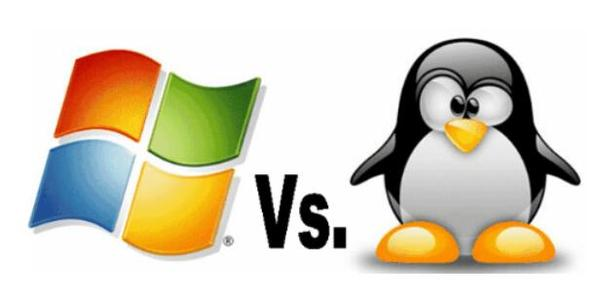
Differences Between Linux and Windows
Free vs Paid
In China, both Windows and Linux are free for personal users, but Windows requires payment for commercial users, while Linux is free.
Technical Support
Windows provides a comprehensive help system, whereas most Linux users rely on technical communities for support. They can obtain useful information from chat boards and forums. The downside is that it often takes a long time to get answers.
Security
Security is a very important issue. Both systems have vulnerabilities and potential security issues. Many administrators claim that Linux has more vulnerabilities than Windows, which is certainly related to its open-source nature. However, if you have a good administrator, security should not be a major issue, regardless of which operating system you use.
Open Source
Open source means that the software source code is open to the public. Linux is open source, while Windows is not.
Main Features of Linux

Basic Philosophy
The basic philosophy of Linux has two points: first, everything is a file; second, each file has a specific purpose. The first point means that everything in the system is reduced to a file, including commands, hardware, software devices, operating systems, processes, etc., all of which are treated as files with their own characteristics or types by the operating system kernel. The fact that Linux is based on Unix is largely due to the similarity of their basic philosophies.
Completely Free
Linux is a free operating system that users can obtain for free via the internet or other means, and can modify its source code at will. This is something other operating systems cannot do. Because of this, countless programmers from around the world participate in modifying and writing Linux, allowing it to absorb the essence of many programmers and continue to grow.
Fully Compatible with POSIX 1.0 Standard
This allows common DOS and Windows programs to run under Linux through corresponding emulators. This lays the foundation for users transitioning from Windows to Linux. Many users consider whether the programs they commonly used under Windows can run normally on Linux, and this concern is alleviated.
Multi-user, Multi-tasking
Linux supports multiple users, each with their own specific rights to their files and devices, ensuring that users do not affect each other. Multi-tasking is a major feature of modern computers, and Linux allows multiple programs to run simultaneously and independently.
Good Interface
Linux has both character and graphical interfaces. In the character interface, users can input corresponding commands via the keyboard to operate. It also provides a graphical interface similar to Windows through the X-Window system, allowing users to operate with a mouse. The X-Window environment is similar to Windows, making it a Linux version of Windows.
Supports Multiple Platforms
Linux can run on various hardware platforms, such as those with x86, 680×0, SPARC, Alpha processors, etc. Additionally, Linux is an embedded operating system that can run on PDAs, set-top boxes, or game consoles. The Linux 2.4 kernel released in January 2001 fully supports Intel’s 64-bit chip architecture. At the same time, Linux also supports multiprocessor technology, allowing multiple processors to work simultaneously, greatly enhancing system performance.
Features of Windows

Excellent Human-Computer Interaction of Windows Operating System
The operating system is the platform that allows humans to communicate with computer hardware. Without good human-computer interaction, it is difficult to attract a large number of users. In the mobile phone sector, Nokia was able to occupy half of the mobile phone market due to its good interactive mobile operating system, and its rapid decline was also due to the outdated operating system. The Windows operating system can be the mainstream operating system for personal computers due to its excellent human-computer interaction. The Windows operating system has a friendly interface, beautiful window design, easy-to-learn operations, good inheritance between generations of systems, and high efficiency in computer resource management.
Windows Operating System Supports a Wide Range of Applications
As an excellent operating system, the Windows operating system is controlled by Microsoft, which develops the operating system’s interface and design, and has open standards. Therefore, many commercial companies develop commercial software for this operating system. The extensive application software available for the Windows operating system provides convenience for users.
These applications are diverse, fully functional, and offer good user experience. For instance, the Windows operating system has a large number of multimedia applications that manage multimedia resources, allowing customers to enjoy multimedia experiences simply by using these commercially developed software.
Good Hardware Support of Windows Operating System
The good adaptability of hardware is an important feature of the Windows operating system. The Windows operating system supports a wide range of hardware platforms, providing a broad and free development environment for hardware manufacturers, encouraging these hardware companies to choose to match with the Windows operating system, and motivating the Windows operating system to continuously improve and enhance. Additionally, the advancement of hardware technology supports the expansion of operating system functions.
Moreover, the operating system supports hot-swapping of various hardware, facilitating user experience and gaining popularity among users.
Whether it is Linux or Windows, both require learning. So let’s also learn about the 7-day “Ali ALoT WIFI Development Training Camp”. Real development courses from Ali IoT, with Huawei technology experts guiding you hands-on, full of practical knowledge to enhance your resume!
Real development courses from Ali IoT, with Huawei technology experts guiding you hands-on, full of practical knowledge to enhance your resume!
 【Ali Development Project Course】: Original price 1299 yuan, now we have secured 【30 discount spots】 for everyone
【Ali Development Project Course】: Original price 1299 yuan, now we have secured 【30 discount spots】 for everyone Two registration methods for flexible choice: ① Individual registration 49.9 yuan, ② Group of 3 for 9.9 yuan/person (you can invite classmates and friends to learn together)
Two registration methods for flexible choice: ① Individual registration 49.9 yuan, ② Group of 3 for 9.9 yuan/person (you can invite classmates and friends to learn together)
Don’t hesitate! As long as you want to learn, this is for you. Hurry up and scan the code to register~ Don’t worry about the group, there are many people who want to learn, and they will join you!
Note: Students enrolled in formal courses at Huqing + students who have registered for any hardware activity cannot register! (If found, the registration fee will be refunded)

















End
● What Level Counts as Proficient in Linux?
● Come on, Be the Most Profitable Programmer
● Technical Insights | How to Learn Embedded Systems and Microcontrollers (STM32)